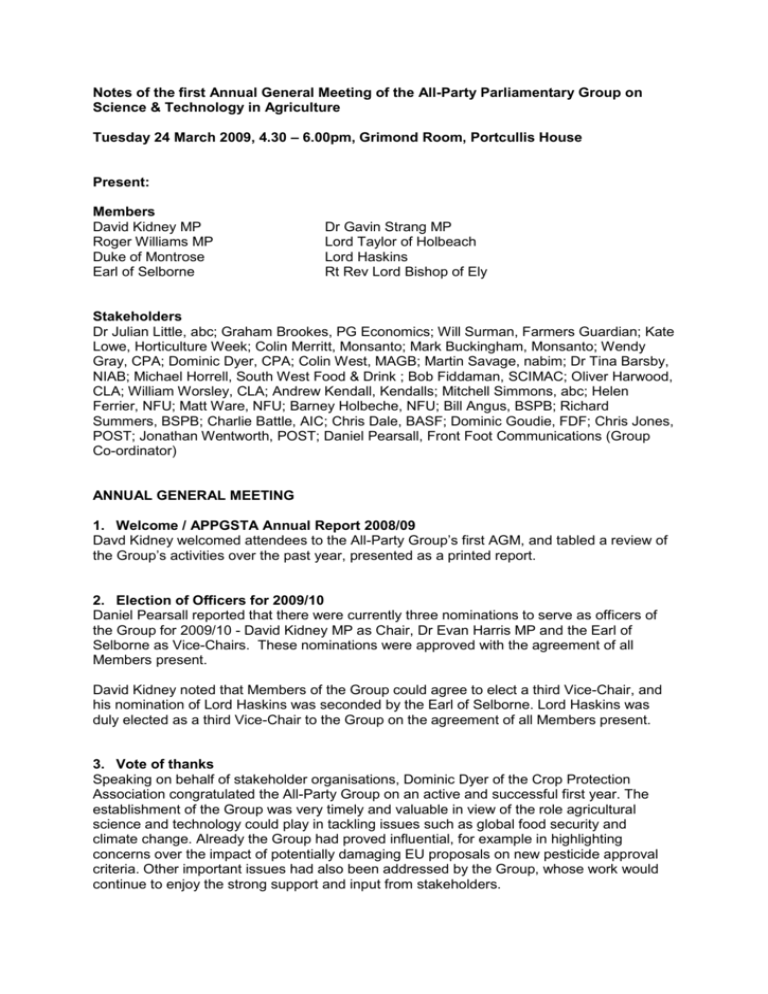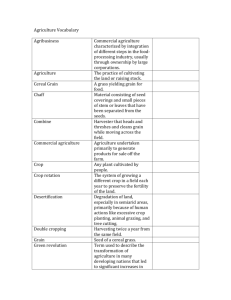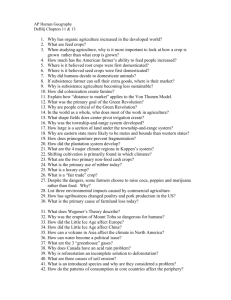Minutes - All-Party Parliamentary Group on Science & Technology in
advertisement

Notes of the first Annual General Meeting of the All-Party Parliamentary Group on Science & Technology in Agriculture Tuesday 24 March 2009, 4.30 – 6.00pm, Grimond Room, Portcullis House Present: Members David Kidney MP Roger Williams MP Duke of Montrose Earl of Selborne Dr Gavin Strang MP Lord Taylor of Holbeach Lord Haskins Rt Rev Lord Bishop of Ely Stakeholders Dr Julian Little, abc; Graham Brookes, PG Economics; Will Surman, Farmers Guardian; Kate Lowe, Horticulture Week; Colin Merritt, Monsanto; Mark Buckingham, Monsanto; Wendy Gray, CPA; Dominic Dyer, CPA; Colin West, MAGB; Martin Savage, nabim; Dr Tina Barsby, NIAB; Michael Horrell, South West Food & Drink ; Bob Fiddaman, SCIMAC; Oliver Harwood, CLA; William Worsley, CLA; Andrew Kendall, Kendalls; Mitchell Simmons, abc; Helen Ferrier, NFU; Matt Ware, NFU; Barney Holbeche, NFU; Bill Angus, BSPB; Richard Summers, BSPB; Charlie Battle, AIC; Chris Dale, BASF; Dominic Goudie, FDF; Chris Jones, POST; Jonathan Wentworth, POST; Daniel Pearsall, Front Foot Communications (Group Co-ordinator) ANNUAL GENERAL MEETING 1. Welcome / APPGSTA Annual Report 2008/09 Davd Kidney welcomed attendees to the All-Party Group’s first AGM, and tabled a review of the Group’s activities over the past year, presented as a printed report. 2. Election of Officers for 2009/10 Daniel Pearsall reported that there were currently three nominations to serve as officers of the Group for 2009/10 - David Kidney MP as Chair, Dr Evan Harris MP and the Earl of Selborne as Vice-Chairs. These nominations were approved with the agreement of all Members present. David Kidney noted that Members of the Group could agree to elect a third Vice-Chair, and his nomination of Lord Haskins was seconded by the Earl of Selborne. Lord Haskins was duly elected as a third Vice-Chair to the Group on the agreement of all Members present. 3. Vote of thanks Speaking on behalf of stakeholder organisations, Dominic Dyer of the Crop Protection Association congratulated the All-Party Group on an active and successful first year. The establishment of the Group was very timely and valuable in view of the role agricultural science and technology could play in tackling issues such as global food security and climate change. Already the Group had proved influential, for example in highlighting concerns over the impact of potentially damaging EU proposals on new pesticide approval criteria. Other important issues had also been addressed by the Group, whose work would continue to enjoy the strong support and input from stakeholders. 4. OPEN MEETING GM crops present & future – is it time to re-open the debate? [Full copies of speakers’ slide presentations are available on the Meetings section of the APPGSTA web-site]. First guest speaker Graham Brookes (GB) of PG Economics Ltd introduced himself as an independent agricultural economist, with a particular interest in the global application and impact of GM crop technology. Drawing on peer-reviewed and publicly available data, GB presented his key findings in relation to the impact of global GM crop adoption 1996-2006 – in terms of farm-level income and production, as well as the environmental consequences for pesticide use and greenhouse gas emissions. After 11 years of widespread use, GB concluded that biotech crops had yielded a net increase of $33.8 billion in farm income while reducing pesticide active ingredient use by 286 million kg and, in 2006 alone, cutting carbon dioxide emissions by 14.8 billion kg – equivalent to taking 6.6 million cars off the road. In 2006, GM crops had delivered a $6.9 billion benefit to global farm income from six biotech traits in four major crops – herbicide tolerance (HT) in soybeans, maize, cotton and canola, and insect resistance (IR) in cotton and maize. This was equivalent to adding 3.8% in value to global production of these four crops. GB added that the economic benefits of GM crop technology were not exclusive to developed world agriculture, with 53% of the farm income gain in 2006 enjoyed by farmers in developing countries such as Argentina, Brazil, Paraguay, India and China. Farm income gain within the EU had been limited because only one GM trait – insect resistance in maize - had been approved for commercial cultivation. In 2007, total EU farm income gain from 110,000ha of GM maize was estimated at $28 million, equivalent to $253/ha, based on an average 10% yield advantage of 0.89 tonnes/ha. Other farm level benefits of using GM herbicide tolerant crops included ease of crop management, facilitating no-tillage production systems, and cleaner crops. For GM insect resistant crops, the advantages included reduced risk of crop losses, energy cost savings, improved health for farm-workers through reduced exposure to insecticides, and lower levels of harmful mycotoxins leading to improved crop quality and safety. In calculating the total farm income benefit of $33.bn from 1996-2006, 43% was due to yield gains, the balance was attributed to cost savings. GB noted that while the average yield gain for IR maize and cotton since 1996 had been +5.7% and +11.1% at a global level, the impact of adoption varied considerably by country. For HT crops, the principal benefit was through improved farming systems such as no-tillage production systems. In Argentina, for example, no-tillage systems had helped shorten the soybean production cycle, making a second crop of soya possible after wheat. In 2008, an estimated 30% of the Argentine soybean crop was in second crop soybean. The 286 million kg reduction in pesticide use since 1996 due to GM crop adoption was equivalent to the total annual use of pesticide active ingredient on arable crops within the EU. The most significant GM crop in reducing pesticide use was insect resistant cotton. Reduced greenhouse gas emissions from growing GM crops came from two main sources – reduced fuel use as a result of fewer sprays and cultivations, and reduced soil carbon release due to increased adoption of no-till production systems. GB concluded that GM crop technology, used by more than 12 million farmers on 114 million hectares in 2007, was delivering important economic and environmental benefits. Most farmers in the EU, however, were not enjoying the benefits of higher yields and lower costs, while EU citizens were missing out on environmental benefits. Although the EU had a robust system in place for the science-based evaluation and approval of GM crops, this system was prevented from operating effectively by political interference. Furthermore, the development of unscientific co-existence rules by individual Member States presented additional barriers to GM crop adoption by EU farmers. Second guest speaker Dr Julian Little (JL), chair of the agricultural biotechnology council, focused on the future pipeline for GM crops – including the crops and traits likely to become available, the countries leading developments, and the potential role of public-private partnerships in providing a route to market for GM crops where normal business models might not be applicable. A functioning regulatory system was needed, however, for these pipeline crops and traits to become available. The EU regulatory system for GMO approvals was among the most robust in the world, yet it had failed to approve any GM crops for cultivation since 1998, leaving just one ‘first generation’ GM crop licensed to be grown in the EU – insect resistant maize. The EU regulatory system for food and feed use of imported GM crops was functional and approval decisions were being taken, although with serious delays and backlogs of applications – in 2008, for example, 10 products had entered the approval system, yet only four applications were processed to completion. JL indicated that the pipeline for GM soybean over the next 10-15 years would include both agronomic applications (herbicide tolerance, disease resistance, pest resistance and yield), and crop quality and nutritional traits (high oleic acid to reduce transfats in food processing, low phytate to reduce phosphorus emissions from livestock). Significantly, soybeans had also been modified as a viable source of long-chain Omega-3 fatty acids – recognised as a vital constituent of healthy diets but currently only available through increasingly unsustainable depletion of fish stocks. Already Omega-3 enriched soybeans had been grown in field trials and tested in human clinical trials, and were close to submission for regulatory approval in the US. The future pipeline for GM maize would include agronomic traits (herbicide tolerance, insect resistance), climate-proofing traits (drought tolerance, Nitrogen-use efficiency and modified corn amylase for biofuel production) and nutritional applications (high lysine, increased protein content, reduced phytate). JL also highlighted the increasing trend towards multiple stacked GM traits within the same crop – three stacked traits was increasingly common. Designer GM crops with up to 10 or 12 stacked traits was not out of the question in years to come, to meet the requirements of specific farming conditions. Future GM crops likely to be of relevance to UK farmers would include potatoes modified for blight resistance and for industrial starch quality, herbicide tolerant sugar beet, as well as high value oilseed rape with modified oils to include zero-transfats and healthy Omega-3 fatty acids. JL highlighted the rapid progress taking place with GM crop technology in developing countries such as China and India, with much of the research based in state-owned research institutes and supported by public sector finance. China already had a number of GM crops in commercial cultivation, including cotton, poplar and horticultural crops, while other major crops were well-advanced towards cultivation – including rice, wheat, maize, soybean and oilseed rape. India was in a similar position, with GM cotton already in commercial cultivation and an extensive range of vegetable and other crops at varying stages of development. In addition, public-private partnerships – between biotechnology companies, Governments, universities, research institutes and charities - were increasingly being used to provide a route to market and support GM crop initiatives around the world where normal business models were absent. 5. Questions & discussion Colin West (MAGB) urged caution over simultaneous claims that GM crop technology could be applied to support no-till farming systems and reduce mycotoxin levels in harvested crops. UK-based research had shown that no-till systems in wheat could lead to higher levels of other mycotoxins. Dominic Dyer (CPA) highlighted recent comments by US Scientific Adviser Nina Federoff regarding the impact of drought on European crop yields in recent years, and the increasing significance of biotech traits such as drought tolerance. JL added that latest reports showed that the EU area classified as ‘water-sensitive’ had doubled over the past five years from 17 to 35%. Lord Selborne noted that the developing world would be the focus of food security concerns, and asked what model would deliver the necessary yield increases in staple crops like sorghum and millet. JL considered public private partnerships to be the way forward, as a means of scientific capacity building in developing countries – Kenya and China were good examples of this, where projects were well-advanced to develop water efficient maize and insect resistant rice respectively. GB noted that IR rice in China was likely to be the first major staple food crop to be grown commercially in the developing world. With 0.5m ha of GM rice already in pre-commercial trials in China, and all regulatory hurdles cleared, commercial cultivation was forecast to begin in 2010, with other rice-growing countries in the region expected to follow suit. Dr Gavin Strang MP noted that the major changes in genotypes made possible through genetic modification gave rise to scientific uncertainty over its long-term implications. In view of the push by large companies to get the technology to market, how could regulatory systems handle scientific concerns that not everything was known about the technology and its long-term effects. JL countered that GM products were required to undergo stringent tests not applied to any other form of agricultural crop or input. After 12 years of commercial experience there was not a single documented safety issue associated with GM crops – no 100% guarantees could ever be given, but such a track record of safety offered a high degree of confidence in the technology and its regulation. Lord Haskins commented that the introduction of a new technology such as GM invariably brought downsides as well as benefits. These had not featured in the presentations. Improved weed control, for example, might have negative environmental consequences for biodiversity. Furthermore, the key to public acceptance of the technology would be to demonstrate genuine consumer benefits, not just to win arguments over safety. JL suggested that at a time of heightened concern over food security, farmers should be encouraged to maximise production within fields. Concerns over weed biodiversity should be directed towards the field margins and hedgerows, where 90% of farmland biodiversity was concentrated. GB added that while GM quality traits with direct benefits for consumers had not yet reached the market, it could be argued that first generation crops had brought public benefits – for example in keeping food prices down and delivering environmental improvements. Oliver Harwood (CLA) expressed concern at the benefits claimed for the technology by GB in relation to soil carbon conservation as an indicator of environmental benefit - his understanding was that this was a hotly disputed subject among scientists. In his view it was vitally important in securing future public support and acceptance for this much-needed technology that the terms and language in which it was presented were right. The Rt Rev Lord Bishop of Ely considered that the context and terminology used by the speakers to present the technology were unlikely to sway the public debate. The statistics cited were certainly impressive, but largely irrelevant to a public concerned about issues such as what was natural in farming and food production. JL agreed that it was often difficult to present agricultural applications and technical benefits in a way that was relevant to consumers, but also noted that when GM crops were first discussed, food security had not been an issue of concern, nor had food price inflation. The situation now was very different and there was certainly an increased level of consumer recognition of the need to increase food production and the role of new technology in doing so. Bill Angus (Limagrain), a wheat breeder, returned to the original theme of the meeting. In his view it was certainly time to re-open the GM debate - there was a pressing timetable to produce 50% more wheat in the world just to keep people alive. Hunger was the cause of political conflict and war. After 15 years of the technology’s application there was no sign of any downsides to the technology. If people were concerned about the control of large corporations in applying the technology then there should be a strong role for public private partnerships, but action was needed now. Plant breeding was a long-term business requiring high upfront investment. It was not a tap which could be turned on or off at will and time was already starting to run out. Lord Haskins asked how the European GM approvals system could be viewed by both speakers as scientifically robust, yet criticised at the same time for not working. GB agreed that the regulatory system was strong until products faced EU-27 votes in the Council of Ministers following science-based assessment and advice by the European Food Safety Authority (EFSA). The EU’s stringent, evidence-based approach was consistently undermined and abused by the short-term, populist political positions of a significant number of EU member states (excluding the UK), making common agreement and progress impossible.







